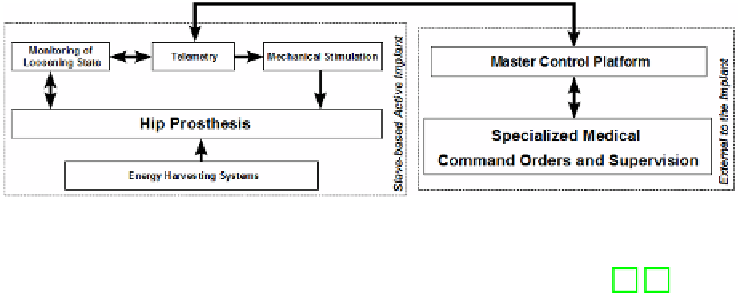Biomedical Engineering Reference
In-Depth Information
Fig. 1.
Block diagram of the new concept of smart orthopaedic implant
load and frequency of mechanical stimulus on the osteogenic responses [35-37], which
contributed to hypothesize that the implementation of mechanisms to carry out artifi-
cial stimulation programs on bone cells can be an effective and efficient solution to
overcome hip loosening. The new concept is based on the
smartness-to-act
methodol-
ogy in order to prevent and cure failures following primary arthroplasty, avoiding the
need of revision procedures. Smart orthopaedic devices must ensure personalized ther-
apy, through: (1) remote communication with external systems outside the human body;
(2) monitoring of physical and biological states which can be used to detect early causes
of failure; (3) decision-making ability when causes of failure are detected; (4) mechan-
ical actuation-based therapy in the physical and biological states which have a deci-
sive influence on the lifetime of the implant, depending on medical supervision. This
long-term survivability biosystem is based on the
tip-of-the-spear
methodology [34],
envisioning the application of Paul Ehrlich's
magic bullet
concept [38] to orthopaedic
devices: implants must have enough “knowledge” and tools to administer the therapy
in the most suitable place and at the most suitable time. To validate the concept, a
prototype is being developed, according to the Fig. 1, in order to enable the early de-
tection and cure of aseptic loosening throughout the life span of the hip prosthesis.
The methodology is based on the implementation of mechanical micro-stimulation to
remodel the bone surrounding the implant in the regions where loosening is detected.
Several subsystems were already implemented by this research team toward the valida-
tion of a new concept of smart hip prostheses, namely: (1) a generator of electric energy
based on double permanent magnet vibration, as well as power management schemes
[27]; (2) a telemetric architecture [24, 27, 39]; (3) a piezoresistive-based mechanism
to detect prosthetic loosening [26]; (4) a piezoelectric-based stimulation mechanism
[35, 40, 41].
3
Material and Methods
3.1
Hip Prosthesis Prototype
A
Metabloc
TM
straight stem system (
Zimmer
Corporate, Warsaw, Indiana, EUA), size
10, was hollowed to design a hip prosthesis prototype comprising three vibration-based
electric power generators (Fig. 2). Fatigue tests on hollow bone implants were already
conducted [16], which have proved the safety of the approach.









Search WWH ::

Custom Search